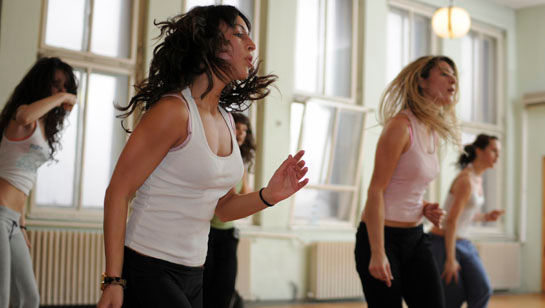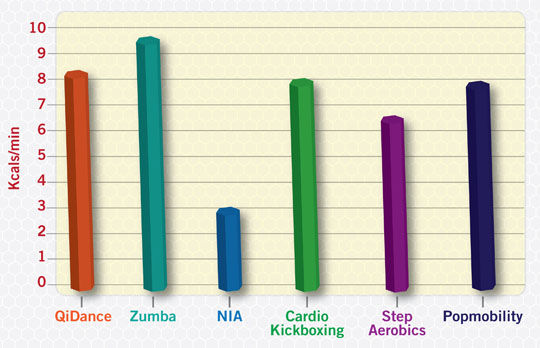

Is this new group exercise trend worth your time? Exclusive ACE research brings you the answer.
By Megan E. Buermann, M.S., John P. Porcari, Ph.D., Cordial Gillette, Ph.D., and Carl Foster, Ph.D.
Since first emerging in the late 1960s, dance aerobics has provided legions of would-be exercisers with an effective alternative to traditional fitness workouts. Originally made popular by the JazzerciseTM franchise and Jacki Sorenson’s Aerobic Dancing, dance-style aerobics have ebbed and flowed in popularity over the years. Though largely overshadowed during the 1990s by cardio kickboxing, step aerobics and indoor cycling, dance aerobics has once again gained momentum with the rise of popular group-exercise programs like ZumbaTM fitness and, now, QiDance.
Developed by Colombian composer, producer and medical doctor Kike Santander, QiDance merges the Eastern concept of Qi (pronounced “key”), essentially meaning vital energy or life force, with pre-choreographed dance routines set to lively World Music. While Santander has created and produced Grammy-winning music for the likes of Carlos Santana, Gloria Estefan and Jennifer Lopez, these days his focus is largely on improving the fitness of everyday exercisers. Thanks to his engaging original music, which spans genres from Latin to Bollywood to African to hip-hop, and high-energy choreography, QiDance is quickly growing in popularity in fitness clubs nationwide.
Responding to this rapid growth and increased interest, the nation’s Workout Watchdog, the American Council on Exercise, sponsored an exclusive study to evaluate the fitness benefits and calorie-burning potential of QiDance.

In 2005, in Barcelona, Spain, Santander first launched Batuka, a Latin music-inspired group fitness program, choreographed to his original songs. It was an immediate hit in that country, selling 1.5 million DVDs in the first 16 months. But in 2012, Santander expanded the program worldwide to include a wider variety of ethnic-inspired music and rebranded it as QiDance.
The Study
Led by John Porcari, Ph.D., and Megan E. Buermann, M.S., researchers from the University of Wisconsin-La Crosse’s Department of Exercise and Sport Science recruited 20 healthy, relatively fit female volunteers ages 18 to 25, all of whom had previous experience participating in aerobic dance classes.
To accurately gauge the exercise intensity of QiDance, researchers needed to monitor each subjects’ heart rate (HR) and oxygen consumption (VO2) throughout a typical QiDance group exercise class. However, standard metabolic testing gear is bulky and wearing it would encumber the subjects’ ability to dance and properly participate in the class. So researchers had each subject take a treadmill-based maximal exercise test. In addition to establishing a baseline of fitness, this test also enabled researchers to develop individual linear regression equations for each subject to predict their VO2 based on HR readings, thus eliminating the need for subjects to wear cumbersome metabolic-testing gear during the dance portion of the testing. To confirm the validity of these equations, the research team did pilot studies on three of the subjects who wore the metabolic gear, during both the maximal test and during a video-based simulated QiDance class featuring a variety of common QiDance moves.
Following treadmill testing, subjects were given a QiDance DVD to practice the aerobic routine at least three times prior to the actual group-exercise testing session. For the final testing, each subject was outfitted with a heart-rate monitor to record HR every minute of the 52-minute session, which was led by a certified QiDance instructor. Ratings of perceived exertion (RPE) using the Borg RPE Scale were also recorded for each subject immediately following the QiDance class. Next, the HR readings taken each minute during the session were put into the regression equations to determine each subject’s VO2 data.
The Results
Based on the data, researchers concluded that participating in a single 52-minute QiDance group exercise class burned an average of 433 calories, or about 8.3 kcals per minute (Table 1). The average HR recorded during the class was 158 bpm, which falls between 68 percent and 95 percent of HRmax. Meanwhile, the average predicted VO2 was between 47 percent and 92 percent of VO2max. As for RPE, the average rating was between 12 and 16 (on a scale of 620).
| Table 1. Average Exercise Responses to a Typical QiDance Class |
| |
Mean ± SD
|
Range
|
| Heart rate (bpm) |
158 ± 10.4 |
126–188 |
| % HRmax |
82 ± 7.5 |
68–95 |
| Predicted VO2 (mL/kg/min) |
28.2 ± 3.36 |
18.1−36.3 |
| % VO2max |
69 ± 12.6 |
47−92 |
| METs |
8.1 ± 0.96 |
5.2−10.4 |
| Kcal/min |
8.3 ± 0.99 |
5.9−11.4 |
| Kcal/total |
433 ± 76.0 |
306−591 |
| RPE |
14.0 ± 0.89 |
12−16 |
Researchers noted that the HRmax and VO2max responses for all of the subjects fell within the range of established industry guidelines for improving cardiorespiratory fitness, as well as for weight loss and weight maintenance.
“We found it was a pretty high-intensity workout,” says lead researcher Megan E. Buermann, M.S. “Some of the subjects’ heart rates were absolutely through the roof. QiDance expended much more than 400 calories per session, so it could definitely be used effectively for individuals who want to lose weight or maintain their weight.”
How Does QiDance Measure Up to Other Forms of Aerobic Dance Exercise?

The Bottom Line
“QiDance is a great workout,” insists Buermann.
In addition to its vigorous calorie burning and easily meeting industry recommendations for maintaining cardiorespiratory fitness and weight loss, QiDance is also notable because it offers a full-body workout. The key: A well-designed, proprietary choreography that uses changes in the music to vary intensities and the muscle groups targeted.
“It’s not like doing robotic line dancing. QiDance is more like people dancing in clubs. It involves a wide range of whole-body movements—forward, backward, side-to-side—not just dancing in place. The more body parts you have moving, the better your workout is going to be,” says Dr. John Porcari, head of the University’s Department of Exercise and Sport Science. “And the more you can stay with the beat of the music, the better workout you’re going to get.”
However, perhaps one of the most important findings about QiDance is one that’s difficult to quantify in a scientific study: the fun factor.
“It’s a really fun 52-minute workout where you’re dancing and you don’t feel like you’re working out. But after you’re done, you realize your heart rate is through the roof and that you are huffing and puffing,” says Buermann. “I think it’s just so crucial for the fitness industry to find things that attract people to be more physically active, because if you’re able to make it more fun people will be more willing to stick with it.”
Using fun and effectiveness as a measuring stick, it’s clear that QiDance is one fitness trend that’s definitely on the right track.
This study was funded solely by a grant from the American Council on Exercise (ACE).
© 2012 The American Council on Exercise. All rights reserved. “ACE”, “The American Council on Exercise” (and logos) and “Workout Watchdog, The American Council on Exercise” are Registered Trademarks of the American Council on Exercise. Other referenced trademarks belong to others.